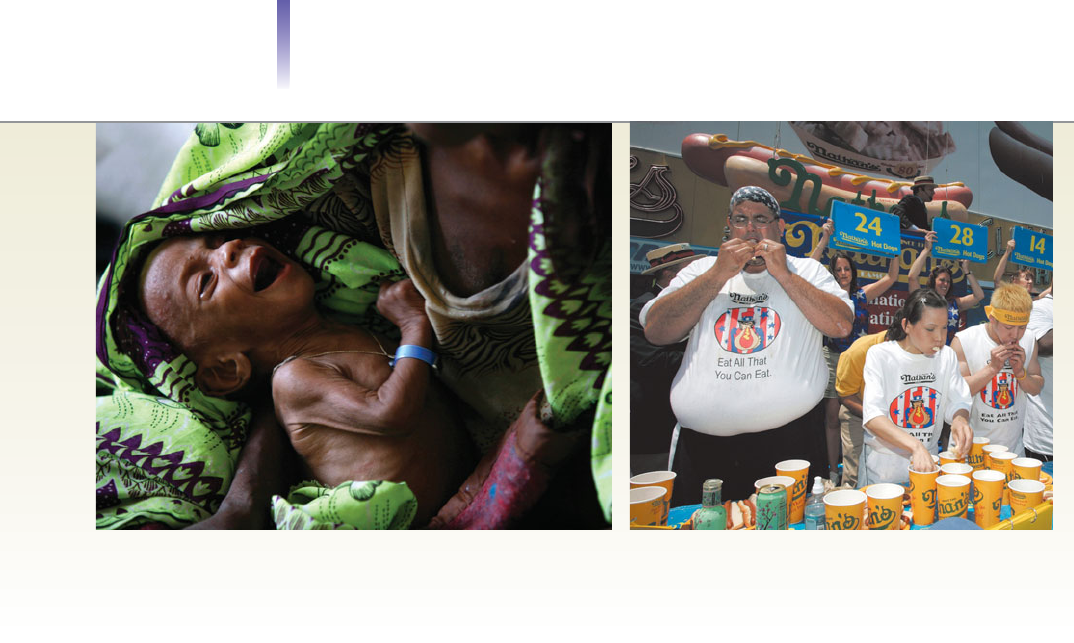Henslin James M. Sociology: A Down to Earth Approach
Подождите немного. Документ загружается.


he image still haunts me. There stood Celia,
age 30, her distended stomach visible proof that
her thirteenth child was on its way. Her oldest was only
14 years old! A mere boy by our standards, he had already gone
as far in school as he ever would. Each morning, he joined the men
to work in the fields. Each
evening around twilight, I
saw him return home, ex-
hausted from hard labor in
the subtropical sun.
I was living in Colima,
Mexico, and Celia and Angel
had invited me for dinner.
Their home clearly reflected the family’s poverty. A thatched hut
consisting of only a single room served as home for all fourteen
members of the family. At night, the parents and younger children
crowded into a double bed, while the eldest boy slept in a ham-
mock. As in many homes in the village, the other children slept on
mats spread on the dirt floor—despite the crawling scorpions.
The home was meagerly furnished. It had only a gas stove, a
table, and a cabinet where Celia stored her few cooking utensils
and clay dishes. There were no closets; clothes hung on pegs in the
walls. There also were no chairs, not even one. I was used to the
poverty in the village, but this really startled me. The family was
too poor to afford even a single chair.
Celia beamed as she told me how much she looked forward to
the birth of her next child. Could she really mean it? It was hard to
imagine that any woman would want to be in her situation.
Yet Celia meant every word. She was as full of delighted antici-
pation as she had been with her first child—and with all the others
in between.
How could Celia have wanted so many children—especially
when she lived in such poverty? That question bothered me.
I couldn’t let it go until I understood why.
This chapter helps to provide an answer.
T
There stood Celia, age 30,
her distended stomach
visible proof that her
thirteenth child was
on its way.
591
Nigeria

Population in Global Perspective
Celia’s story takes us into the heart of demography, the study of the size, composition,
growth, and distribution of human populations. It brings us face to face with the ques-
tion of whether we are doomed to live in a world so filled with people that there will be
very little space for anybody. Will our planet be able to support its growing population?
Or are chronic famine and mass starvation the sorry fate of most earthlings?
Let’s look at how concern about population growth began.
A Planet with No Space for Enjoying Life?
The story begins with the lowly potato. When the Spanish conquistadores found that peo-
ple in the Andes Mountains ate this vegetable, which was unknown in Europe, they
brought some home to cultivate. At first, Europeans viewed the potato with suspicion, but
gradually it became the main food of the lower classes. With a greater abundance of food,
fertility increased, and the death rate dropped. Europe’s population soared, almost dou-
bling during the 1700s (McKeown 1977; McNeill 1999).
Thomas Malthus (1766–1834), an English economist, saw this surging growth as a sign
of doom. In 1798, he wrote a book that became world famous, An Essay on the Principle
of Population (1798). In it, Malthus proposed what became known as the Malthus
theorem. He argued that although population grows geometrically (from 2 to 4 to 8 to
16 and so forth), the food supply increases only arithmetically (from 1 to 2 to 3 to 4 and
so on). This meant, he claimed, that if births go unchecked, the population of a country,
or even of the world, will outstrip its food supply.
The New Malthusians
Was Malthus right? This question has become a matter of heated debate among demog-
raphers. One group, which can be called the New Malthusians, is convinced that today’s
situation is at least as grim as—if not grimmer than—Malthus ever imagined. For exam-
ple, the world’s population is growing so fast that in just the time it takes you to read this chap-
592 Chapter 20 POPULATION AND URBANIZATION
In earlier generations, large farm
families were common. Having
many children was functional—
more hands to help with
planting, harvesting, and food
preparation. As the country
industrialized and urbanized and
children became expensive and
nonproducing, the size of families
shrank. This photo was taken in
1938 in Crowley, Louisiana.
demography the study of
the size, composition, growth,
and distribution of human
populations
Malthus theorem an obser-
vation by Thomas Malthus that
although the food supply in-
creases arithmetically (from 1
to 2 to 3 to 4 and so on),
population grows geometrically
(from 2 to 4 to 8 to 16 and
so forth)

ter, another 20,000 to 40,000 babies will be born! By this time tomorrow, the earth will have
about 224,000 more people to feed. This increase goes on hour after hour, day after day,
without letup. For an illustration of this growth, see Figure 20.1.
The New Malthusians point out that the world’s population is following an
exponential growth curve. This means that if growth doubles during approximately
equal intervals of time, it suddenly accelerates. To illustrate the far-reaching implications
of exponential growth, sociologist William Faunce (1981) retold an old parable about a
poor man who saved a rich man’s life. The rich man was grateful and said that he wanted
to reward the man for his heroic deed.
The man replied that he would like his reward to be spread out over a four-week period,
with each day’s amount being twice what he received on the preceding day. He also said he
would be happy to receive only one penny on the first day. The rich man immediately handed
over the penny and congratulated himself on how cheaply he had gotten by.
At the end of the first week, the rich man checked to see how much he owed and was pleased
to find that the total was only $1.27. By the end of the second week he owed only $163.83. On
the twenty-first day, however, the rich man was surprised to find that the total had grown to
$20,971.51. When the twenty-eighth day arrived the rich man was shocked to discover that he
owed $1,342,177.28 for that day alone and that the total reward had jumped to $2,684,354.56!
This is precisely what alarms the New Malthusians. They claim that humanity has just
entered the “fourth week” of an exponential growth curve. Figure 20.2 shows why they
A Planet with No Space for Enjoying Life? 593
S
M
T
WT
F
S
S
M
T
WT
F
S
S
M
T
WT
F
S
S
M
T
WT
F
S
The Accumulating Increase
Each second
2.6
Each minute
156
Each hour
9,350
Each day
224,000
Each week
1,576,000
Each month
6,828,000
Each year
82,000,000
The Results of a Single Day
Add
Minus
Equals
0 50 100 150 200 250 300 350 400
Births
Deaths
Population increase
380,000
156,000
224,000
FIGURE 20.1 How Fast Is the World’s Population Growing?
Source: By the author. Based on Haub and Kent 2008.
Only 300 million
people in the world?
The birth
of Christ
1
0
2
3
4
5
6
7
Billions of People
Billions of People
200
Year
400 600 800 1000 1200 1400 1600 1800 2000 2200
8
9
10
11
1
0
2
3
4
5
6
7
8
9
10
11
1800
1930
1960
1975
1987
1999
2013?
2100
Projected
FIGURE 20.2 World Population Growth Over 2,000 Years
Sources: Modified from Piotrow 1973; McFalls 2007.
exponential growth curve
a pattern of growth in which
numbers double during ap-
proximately equal intervals,
showing a steep acceleration in
the later stages

think the day of reckoning is just around the corner. It took from the beginning of time
until 1800 for the world’s population to reach its first billion. It then took only 130 years
(1930) to add the second billion. Just 30 years later (1960), the world population hit 3
billion. The time it took to reach the fourth billion was cut in half, to only 15 years (1975).
Then just 12 years later (in 1987), the total reached 5 billion, and in another 12 years it
hit 6 billion (in 1999).
On average, every minute of every day, 156 babies are born. As Figure 20.1 shows, at
each sunset the world has 224,000 more people than it did the day before. In a year, this
comes to 82 million people. During the next four years, this increase will total more than
the entire U.S. population. Think of it this way: In just the next 12 years, the world will
add as many people as it did during the entire time from when the first humans began to walk
the earth until the year 1800.
These totals terrify the New Malthusians. They are convinced that we are headed
toward a showdown between population and food. In the year 2050, the population of
just India and China is expected to be more than the entire world’s population was in
1950 (Haub and Kent 2008). It is obvious that we will run out of food if we don’t
curtail population growth. Soon we are going to see more televised images of pitiful,
starving children.
The Anti-Malthusians
All of this seems obvious, and no one wants to live shoulder-to-shoulder and fight for
scraps. How, then, can anyone argue with the New Malthusians?
An optimistic group of demographers, whom we can call the Anti-Malthusians, paint
a far different picture. They believe that Europe’s demographic transition provides a
more accurate glimpse into the future. This transition is diagrammed in Figure 20.3. Dur-
ing most of its history, Europe was in Stage 1. Its population remained about the same
from year to year, for high death rates offset the high birth rates. Then came Stage 2, the
“population explosion” that so upset Malthus. Europe’s population surged because birth
rates remained high while death rates went down. Finally, Europe made the transition to
Stage 3: The population stabilized as people brought their birth rates into line with their
lower death rates.
This, say the Anti-Malthusians, will also happen in the Least Industrialized Nations.
Their current surge in population growth simply indicates that they have reached Stage 2
594 Chapter 20 POPULATION AND URBANIZATION
Stable population:
Births and deaths
are more or less
balanced.
Rapidly growing
population:
Births far
outnumber deaths.
Stable population:
Births drop, and births
and deaths become
more or less balanced.
Death rate
Birth rate
Population
increase
Population
decrease
Shrinking
population:
Deaths outnumber
births.
STAGE 1
STAGE 2 STAGE 3 STAGE 4
FIGURE 20.3 The Demographic Transition
Note: The standard demographic transition is depicted by Stages 1–3. Stage 4 has been suggested
by some Anti-Malthusians.
demographic transition a
three-stage historical process
of population growth: first, high
birth rates and high death
rates; second, high birth rates
and low death rates; and third,
low birth rates and low death
rates; a fourth stage in which
deaths outnumber births has
made its appearance in the
Most Industrialized Nations

of the demographic transition. Hybrid seeds, medicine from the Most Industrialized Na-
tions, and purer public drinking water have cut their death rates, while their birth rates
have remained high. When they move into Stage 3, as surely they will, we will wonder
what all the fuss was about. In fact, their growth is already slowing.
Who Is Correct?
As you can see, both the New Malthusians and the Anti-Malthusians have looked at his-
torical trends and projected them onto the future. The New Malthusians project contin-
ued world growth and are alarmed. The Anti-Malthusians project Stage 3 of the
demographic transition onto the Least Industrialized Nations and are reassured.
There is no question that the Least Industrialized Nations are in Stage 2 of the demo-
graphic transition. The question is, Will these nations enter Stage 3? After World War II,
the West exported its hybrid seeds, herbicides, and techniques of public hygiene around
the globe. Death rates plummeted in the Least Industrialized Nations as their food sup-
ply increased and health improved. Because their birth rates stayed high, their populations
mushroomed. This alarmed demographers, just it had Malthus 200 years earlier. Some
predicted worldwide catastrophe if something were not done immediately to halt the pop-
ulation explosion (Ehrlich and Ehrlich 1972, 1978).
We can use the conflict perspective to understand what happened when this message
reached the leaders of the industrialized world. They saw the mushrooming populations
of the Least Industrialized Nations as a threat to the global balance of power they had so
carefully worked out. With swollen populations, the poorer countries might demand a
larger share of the earth’s resources. The leaders found the United Nations to be a willing
tool, and they used it to spearhead efforts to reduce world population growth. The results
have been remarkable. The annual growth of the Least Industrialized Nations has dropped
29 percent, from an average of 2.1 percent a year in the 1960s to 1.5 percent today (Haub
and Yinger 1994; Haub and Kent 2008).
The New Malthusians and Anti-Malthusians have greeted this news with significantly
different interpretations. For the Anti-Malthusians, this slowing of growth is the signal
they had been waiting for: Stage 3 of the demographic transition has begun. First, the
death rate in the Least Industrialized Nations fell—now, just as they predicted, birth rates
are also falling. Did you notice, they would say, if they looked at Figure 20.2, that it took
twelve years to add the fifth billion to the world’s population—and also twelve years to
add the sixth billion? Population momentum is slowing. The New Malthusians reply that
a slower growth rate still spells catastrophe—it just takes longer for it to hit.
The Anti-Malthusians also argue that our future will be the opposite of what the New
Malthusians worry about: There are going to be too few children in the world, not too
many. The world’s problem will not be a population explosion, but population shrinkage—
populations getting smaller. They point out that births in sixty-five countries have already
dropped so low that those countries no longer produce enough children to maintain their
populations. About half of the countries of Europe fill more coffins than cradles (Haub and
Kent 2008). Apparently, they all would if it were not for immigration from Africa.
Some Anti-Malthusians even predict a “demographic free fall” (Mosher 1997). As more
nations enter Stage 4 of the demographic transition, the world’s population will peak at
about 8 or 9 billion, then begin to grow smaller. Two hundred years from now, they say,
we will have a lot fewer people on earth.
Who is right? It simply is too early to tell. Like the proverbial pessimists who see the glass
of water half empty, the New Malthusians interpret changes in world population growth neg-
atively. And like the eternal optimists who see the same glass half full, the Anti-Malthusians
view the figures positively. Sometime during our lifetime we should know the answer.
Why Are People Starving?
Pictures of starving children gnaw at our conscience. We live in such abundance, while
these children and their parents starve before our very eyes. Why don’t they have enough
food? Is it because there are too many of them, or simply because the abundant food the
world produces does not reach them?
A Planet with No Space for Enjoying Life? 595
population shrinkage the
process by which a country’s
population becomes smaller
because its birth rate and
immigration are too low to
replace those who die and
emigrate

The Anti-Malthusians make a point that seems irrefutable. As Figure 20.4 on the next
page shows, there is more food for each person in the world now than there was in 1950. Al-
though the world’s population has more than doubled since 1950, improved seeds and fer-
tilizers have made more food available for each person on earth. Even more food may be
on the way, for bioengineers are making breakthroughs in agriculture. Despite droughts
and civil wars, the global production of meat, fish, and cereals (grains and rice) contin-
ues to increase (“Food Outlook” 2008; “Crop Prospects” 2009).
Then why do people die of hunger? From Figure 20.4, we can conclude that people
don’t starve because the earth produces too little food, but because particular places lack
food. Droughts and wars are the main reasons. Just as droughts slow or stop food produc-
tion, so does war. In nations ravaged by civil war, opposing sides either confiscate or burn
crops, and farmers flee to the cities (Thurow 2005; Gettleman 2009). While some coun-
tries suffer like this, others are producing more food than their people can consume. At
the same time that countries of Africa are hit by drought and civil wars—leaving a swath
of starving people—the U.S. government pays farmers to reduce their crops. The United
States’ problem is too much food; West Africa’s is too little.
The New Malthusians counter with the argument that the world’s population is still
growing and that we don’t know how long the earth will continue to produce enough food.
They add that the recent policy of turning food (such as corn and sugar cane) into biofu-
els (such as gasoline and diesel fuel) is short-sighted, posing a serious threat to the world’s
food supply. They also remind us of the penny doubling each day. It is only a matter of
time, they insist, until the earth no longer produces enough food—not “if,” but “when.”
Both the New Malthusians and the Anti-Malthusians have contributed significant
ideas, but theories will not eliminate famines. Starving children are going to continue to
peer out at us from our televisions and magazines, their tiny, shriveled bodies and bloated
stomachs nagging at our conscience and imploring us to do something. Regardless of the
underlying causes of this human misery, it has a simple solution: Food can be transferred
from nations that have a surplus.
These pictures of starving Africans leave the impression that Africa is overpopulated.
Why else would all those people be starving? The truth, however, is far different. Africa
has 23 percent of the earth’s land, but only 14 percent of the earth’s population (Haub and
Kent 2008). Africa even has vast areas of fertile land that have not yet been farmed. The
reason for famines in Africa, then, cannot be too many people living on too little land.
596 Chapter 20 POPULATION AND URBANIZATION
Photos of starving people, such as this mother and her child, haunt Americans and other members of
the Most Industrialized Nations. Many of us wonder why, when some are starving, we should live in the
midst of such abundance, often overeating and even casually scraping excess food into the garbage. We
even have eating contests to see who can eat the most food in the least time.The text discusses
reasons for such disparities.

Population Growth
Even if starvation is the result of a maldistribution of food rather than overpopulation, the
fact remains that the Least Industrialized Nations are growing thirteen times faster than the
Most Industrialized Nations (Haub and Kent 2008). At these rates, it will take 500 years
for the average Most Industrialized Nation to double its population, but just 40 years for
the average Least Industrialized Nation to do so. Figure 20.5
puts the matter in stark perspective. So does the Down-to-
Earth Sociology box on the next page.
Why the Least Industrialized
Nations Have So Many Children
Why do people in the countries that can least afford it have
so many children? Let’s go back to the chapter’s opening vi-
gnette and try to figure out why Celia was so happy about
having her thirteenth child. It will help if we apply the sym-
bolic interactionist perspective. We must take the role of the
other so that we can understand the world of Celia and
Angel as they see it. As our culture does for us, their culture
provides a perspective on life that guides their choices. Celia
and Angel’s culture tells them that twelve children are not
enough, that they ought to have a thirteenth—as well as a
fourteenth and fifteenth. How can this be? Let’s consider
three reasons why bearing many children plays a central role
in their lives—and in the lives of millions upon millions of
poor people around the world.
Population Growth 597
Per Capita Food Production
10
0
1950 1955 1960 1965 1970 1975 1980 1985 1990 1995Year 2000
20
30
40
50
60
70
80
90
100
2005 20152010
110
120
FIGURE 20.4 How Much Food Does the World Produce Per Person?
Source: By the author. Based on Simon 1981; Food and Agriculture Organization of the United
Nations 2006; Statistical Abstract of the United States 2011:Table1373.
Population in billions
2
0
4
6
8
10
12
1750 1800 1850 1900 1950 2000 2050 2100Year 2150
T
h
e
L
e
a
s
t
I
n
d
u
s
t
r
i
a
l
i
z
e
d
N
a
t
i
o
n
s
T
h
e
M
o
s
t
I
n
d
u
s
t
r
i
a
l
i
z
e
d
N
a
t
i
o
n
s
FIGURE 20.5 World Population Growth,
1750–2150
Source: “The World of the Child 6 Billion” 2000; Haub and
Kent 2008.

First is the status of parenthood. In the Least Industrialized Nations, motherhood is the
most prized status a woman can achieve. The more children a woman bears, the more she
is thought to have achieved the purpose for which she was born. Similarly, a man proves
his manhood by fathering children. The more children he fathers, especially sons, the bet-
ter—for through them his name lives on.
Second, the community supports this view. Celia and those like her live in Gemeinschaft
communities, where people share similar views of life. To them, children are a sign of
598 Chapter 20 POPULATION AND URBANIZATION
How the 2004 Tsunami Can
Help Us to Understand
Population Growth
O
n December 26, 2004, the world witnessed the
worst tsunami in modern history. As the giant
waves rolled over the shores of unsuspecting
countries, they swept away people from all walks of
life—from lowly sellers of fish to wealthy tourists visit-
ing the fleshpots of Sri Lanka. In all, 286,000 people died.
In terms of lives lost, this was not the worst single
disaster the world had seen. Several hundred thousand
people had been killed in China’s Tangshan earthquake
in 1976. In terms of geography, however, this was the
broadest. It involved more countries than any other dis-
aster in modern history. And, unlike its predecessors,
this tsunami occurred during a period of instantaneous,
global reporting of events.
As news of the tsunami was transmitted around the
globe, the response was almost immediate. Aid poured
in—in unprecedented amounts. Governments gave over
$3 billion. Citizens pitched in, too, from Little Leaguers
and religious groups to the “regulars” at the local bars.
I want to use the tsunami disaster to illustrate the in-
credible population growth that is taking place in the
Least Industrialized Nations. My intention is not to dis-
miss the tragedy of these deaths, for they were horri-
ble—as were the maiming of so many, the sufferings
of families, and the lost livelihoods.
Let’s consider Indonesia first. With 233,000 deaths,
this country was hit the hardest. At the time, Indonesia
had an annual growth rate of 1.6 percent (its “rate of
natural increase,” as demographers call it). With a popu-
lation of 220 million, Indonesia was growing by
3,300,000 people each year (Haub 2004). (I’m using the
totals at the time of the tsunami. As I write this in 2009,
Indonesia’s population has already soared to 240 million.)
This increase, coming to 9,041 people each day, means
that it took Indonesia less than four weeks (twenty-six
days) to replace the huge number of people it lost to
the tsunami.
The next greatest loss of lives took place in
Sri Lanka. With its lower rate of natural increase of 1.3
and its smaller population of 19 million, it took Sri Lanka
a little longer to replace the 31,000 people it lost:
forty-six days.
India was the third hardest hit.With India’s 1 billion
people and its 1.7 rate of natural increase, India was
adding 17 million people to its population each year—
46,575 people each day. At an increase of 1,940 people
per hour, India took just 8 or 9 hours to replace the
16,000 people it lost to the tsunami.
The next hardest hit was Thailand. It took Thailand
four or five days to replace the 5,000 people that it lost.
For the other countries, the losses were smaller: 298
for Somalia, 82 for the Maldives; 68 for Malaysia; 61 for
Myanmar, 10 for Tanzania, 2 for Bangladesh, and 1 for
Kenya (“Tsunami deaths . . .” 2005).
Again, I don’t want to detract from the horrifying
tragedy of the 2004 tsunami. But by using this event as a
comparative backdrop, we can gain a better grasp of the
unprecedented population growth that is taking place in
the Least Industrialized Nations.
Down-to-Earth Sociology
This photo was snapped at Koh Raya in Thailand,
just as the tsunami wave of December 26, 2004,
landed.

13.5
13.0
12.5
12.0
11.0
10.5
10.0
9.5
9.0
8.5
8.0
7.5
Caring for chickens/ducks
Caring for younger children
Fetching water
Caring for goats/cattle
Cutting fodder
Harvesting rice
Transplanting rice
Working for wages
Hoeing
Average Age at Which Activity Begins
11.5
13.0
12.9
9.9
9.7
9.5
8.8
9.3
8.0
7.9
God’s blessing. By producing children, people reflect the values of their community,
achieve status, and are assured that they are blessed by God. It is the barren woman, not
the woman with a dozen children, who is to be pitied.
You can see how these factors provide strong motivations for bearing many children.
There is also another powerful incentive: For poor people in the Least Industrialized Na-
tions, children are economic assets. Like Celia and Angel’s eldest son, children begin con-
tributing to the family income at a young age. (See Figure 20.6.) But even more
important: Children are the equivalent of our Social Security. In the Least Industrialized
Nations, the government does not provide social security or medical and unemployment
insurance. This motivates people to bear more children, for when parents become too old
to work, or when no work is to be found, their children take care of them. The more chil-
dren they have, the broader their base of support.
To those of us who live in the Most Industrialized Nations, it seems irrational to have
many children. And for us it would be. Understanding life from the framework of people
who are living it, however—the essence of the symbolic interactionist perspective—reveals
how it makes perfect sense to have many children. Consider this report by a government
worker in India:
Thaman Singh (a very poor man, a water carrier) . . . welcomed me inside his home, gave me
a cup of tea (with milk and “market” sugar, as he proudly pointed out later), and said: “You
were trying to convince me that I shouldn’t have any more sons. Now, you see, I have six
sons and two daughters and I sit at home in leisure. They are grown up and they bring me
money. One even works outside the village as a laborer. You told me I was a poor man and
couldn’t support a large family. Now, you see, because of my large family I am a rich man.”
(Mamdani 1973)
Population Growth 599
FIGURE 20.6 Why the Poor Need Children
Children are an economic asset in the Least Industrialized Nations. Based on a survey in Indonesia, this
figure shows that boys and girls can be net income earners for their families by the age of 9 or 10.
Source: U.N. Fund for Population Activities.

Conflict theorists offer a different view of why women in the Least Industrialized Na-
tions bear so many children. Feminists argue that women like Celia have internalized val-
ues that support male dominance. In Latin America, machismo—an emphasis on male
virility and dominance—is common. To father many children, especially sons, shows that
a man is sexually potent, giving him higher status in the community. From a conflict per-
spective, then, the reason poor people have so many children is that men control women’s
reproductive choices.
Implications of Different Rates of Growth
The result of Celia and Angel’s desire for many children—and of the millions of Celias and
Angels like them—is that Mexico’s population will double in forty years. In contrast, women
in the United States are having so few children that if it weren’t for immigration, the U.S.
population would begin to shrink. To illustrate population dynamics, demographers use
population pyramids. These depict a country’s population by age and sex. Look at Figure 20.7,
which shows the population pyramids of the United States, Mexico, and the world.
To see why population pyramids are important, I would like you to imagine a mira-
cle. Imagine that, overnight, Mexico is transformed into a nation as industrialized as the
United States. Imagine also that overnight the average number of children per woman
drops to 2.1, the same as in the United States. If this happened, it would seem that Mexico’s
population would grow at the same rate as that of the United States, right?
But this isn’t what would happen. Instead, the population of Mexico would grow much
faster than that of the United States. To see why, look again at the population pyramids.
You can see that a much higher percentage of Mexican women are in their childbearing
years. Even if Mexico and the United States had the same birth rate (2.1 children per
woman), a larger percentage of women in Mexico would be giving birth, and Mexico’s
population would grow faster. As demographers like to phrase this, Mexico’s age structure
gives it greater population momentum.
With its population momentum and higher birth rate, Mexico’s population will dou-
ble in forty years. The implications of a doubling population are mind-boggling. Just to
stay even, within forty years Mexico must double the number of available jobs and hous-
ing facilities; its food production; its transportation and communication facilities; its
water, gas, sewer, and electrical systems; and its schools, hospitals, churches, civic build-
ings, theaters, stores, and parks. If Mexico fails to double them, its already meager stan-
dard of living will drop even further.
600 Chapter 20 POPULATION AND URBANIZATION
80+
75–79
70–74
65–69
60–64
55–59
50–54
45–49
40–44
35–39
30–34
25–29
20–24
15–19
10–14
5–9
0–4
765432101234567 54321012345
80+
75–79
70–74
65–69
60–64
55–59
50–54
45–49
40–44
35–39
30–34
25–29
20–24
15–19
10–14
5–9
0–4
6543210123456
Male Female Male Female
Male Female
Percentage of
Total Population
Percentage of
Total Population
Percentage of
Total Population
Mexico
Ages
United States
Ages
The World
FIGURE 20.7 Three Population Pyramids
Source: Population Today, 26, 9, September 1998:4, 5.
population pyramid a
graph that represents the age
and sex of a population (see
Figure 20.7)
